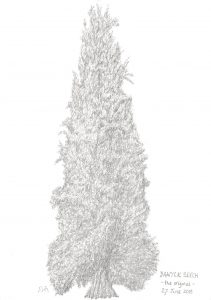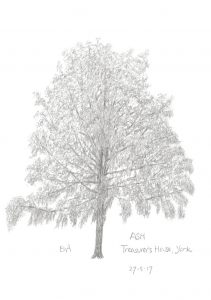St. Edmund Hall founded, it is estimated, in 1236, claims to be the oldest academical society for the education of undergraduates in any university. It is the last surviving medieval hall in Oxford. Over the past few years, Ewan has been drawing the trees in the college grounds as a contribution to its annual exhibition, mounted for the Oxford Arts Week. The college owns four of Ewan’s pictures.
An uncommon and majestic tree, the Narrow Leaved Ash dominates the Museum Gardens in York. Until January 2018, it was listed as a Champion Tree in both height and girth. Unfortunately, as a result of water transmission problems in its outer branches, it had to be pruned. The picture of the tree in its pomp was used by the tree surgeon to carry out the pruning. The second picture shows the tree as it is today.
- 2017
- 2018
With the expected changes in weather, the climate of Britain will become increasingly like that of the Mediterranean. Botanic gardens and parks will gradually take on the appearance of Rundle Gardens with a good deal of bare earth but an array of exotic trees. The pictures illustrate some of these beautiful trees.
 A unique tree, a fastigiate Beech, was discovered by Sir John Naesmyth in the grounds of his house near Peebles. The grounds are now known as Dawyck Gardens, a constituent of the Royal Botanic Gardens, Edinburgh. Naesmyth was the landscape architect for the Museum Gardens in York, which also contain a Dawyck Beech.
A unique tree, a fastigiate Beech, was discovered by Sir John Naesmyth in the grounds of his house near Peebles. The grounds are now known as Dawyck Gardens, a constituent of the Royal Botanic Gardens, Edinburgh. Naesmyth was the landscape architect for the Museum Gardens in York, which also contain a Dawyck Beech.
The drawing shows the original tree, which remains healthy and is the source of all Dawyck Beech trees worldwide.
On the weekend of 16th and 17th September 2017 the John Innes Centre celebrated 50 years of research on its present site in Norwich. Over 3000 visitors attended.
Ewan’s pictures in connection with Ash Dieback were on display and he was asked to draw a venerable and resistant Ash, a dominant feature in the grounds.
 This tree is probably the rarest on the British List. For many years the only known example was a single tree in the Forest of Wyre in Worcestershire. That tree was destroyed by a fire in 1862 but cuttings had been taken from it and one survives as a majestic tree, illustrated here, in the Museum Gardens, York.
This tree is probably the rarest on the British List. For many years the only known example was a single tree in the Forest of Wyre in Worcestershire. That tree was destroyed by a fire in 1862 but cuttings had been taken from it and one survives as a majestic tree, illustrated here, in the Museum Gardens, York.
Recently the position of the True Service Tree as a British native tree has been supported by small isolated populations of the species discovered on cliffs in South Wales, on the slopes of the Avon Gorge near Shirehampton, Bristol, and in the upper reaches of the River Camel in Cornwall.
A Treasurer was first appointed at York Minster in 1071. Since then, his house has undergone many changes and it is now largely 17th century. At the front, there is a beautiful, award-winning garden in which herbaceous plants are clustered and labelled according to species.
The garden is dominated by two mature Ash trees, one on each side, about 30 metres apart. One appears perfectly healthy while the other is in an advanced state of dieback. Ewan drew these trees for the John Innes Open Day to illustrate the ravages of dieback and how two neighbouring trees can be so differently affected.
- Ash (dieback) – A24
- Ash – A23
At present, it seems that the west of England is suffering significantly less from Ash Dieback than the east. This may result from a variety of factors including location, genetic characteristics and sources of recolonisation after the Ice Age. As a measure to facilitate the monitoring of any changes, Ewan has drawn and will continue to draw annually four Ash trees of differing appearance which were planted in the Golden Copse, established in Sidmouth to celebrate the Golden Jubilee of the Queen in 2002.

At a place in Georgia where secret governmental meetings are sometimes held, several US Presidents have planted Live Oak Trees to commemorate their visits. The first was Calvin Coolidge in 1928 and the most recent Bill Clinton in 2012. Ewan was allowed to visit in 2016 and was able to sketch the central group of oaks in preparation for completing a picture.












